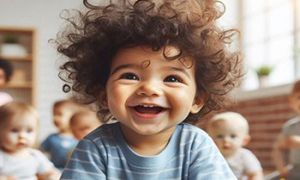Achieving EYLF Outcome 5—Children Are Effective Communicators—in the Babies Room focuses on fostering foundational communication skills in the youngest learners. In an environment where babies largely communicate non-verbally, educators play a crucial role in creating opportunities for both expressive and receptive language development. Here’s how you can integrate practices that support this outcome in the Babies Room.
Strategies To Achieve Outcome 4 With Babies
1. Responsive and Intentional Interactions
Definition: At this stage, babies convey messages through cooing, babbling, facial expressions, and gestures rather than full words. Responsive interactions mean that educators attentively interpret and respond to these cues.
Practical Example: When a baby smiles or reaches out, an educator might mirror the gesture, speak in gentle, engaging tones, and use descriptive language. If a baby vocalizes sounds while looking at a favorite toy, the educator can repeat the sound and describe the toy (e.g., “Yes, that’s a red ball; you like the red ball!”). This kind of back-and-forth helps the baby associate feelings and needs with words and sounds.
2. Incorporating Baby Sign Language
Definition: Baby sign language involves teaching simple signs to support early communication before verbal language is fully developed. This practice reduces frustration and enhances bonding.
Practical Example: During feeding or play routines, an educator might introduce basic signs for common needs like “eat,” “drink,” or “more.” The educator can model these signs repeatedly, ensuring that babies have an additional means of expression, which encourages them to communicate their needs clearly.
Definition: A language-rich environment is one designed to expose babies to a variety of verbal and non-verbal communication forms through everyday materials and interactions.
Practical Example:
-
Story Time & Music: Use board books with bright images and simple stories during group times. Pair these readings with nursery rhymes and songs that emphasize rhythm, repetition, and melody.
-
Interactive Displays: Install visually appealing charts and pictures around the room that label objects or depict everyday activities, subtly introducing vocabulary.
This environment not only supports language acquisition but also encourages visual and auditory stimulation to reinforce emerging communication skills.
4. Multi-Sensory and Play-Based Learning
Definition: Babies learn by exploring the world through their senses. Multi-sensory activities help them link language to tangible experiences.
Practical Example:
-
Sensory Activities: Offer textured toys, water play, or fabrics with various textures. As babies explore these sensory materials, educators can extend the experience by describing sensations (e.g., “soft,” “bumpy,” “wet”) and asking simple, engaging questions even if the baby can only respond with gestures or cooing.
-
Interactive Games: Games like peek-a-boo provide cues for turn-taking and anticipation, essential elements in communication. These moments become teachable instances where smiles, laughter, and eye contact become a language in themselves.
5. Involving Families and Cultures
Definition: Recognizing and including the linguistic and cultural backgrounds of families enriches a baby’s communication experiences and builds a sense of belonging.
Practical Example: Encourage parents to share songs, stories, or simple greetings in their home languages. Educators can weave these into daily routines, such as saying welcome greetings or incorporating multicultural music during group activities. This not only validates the babies’ cultural identities but also introduces them early on to the diverse nature of communication.
6. Utilizing Carefully Selected Digital Tools
Definition: While the primary mode of communication at this age remains face-to-face, carefully moderated digital resources can supplement language development.
Practical Example: Using short, engaging video clips or interactive songs on a smart display—always under close supervision—can introduce new sounds, rhythms, and words. It’s essential that digital tools are used sparingly and complement direct interactions rather than replace them.
Integrating these strategies helps create a nurturing environment where babies are supported as effective communicators from the very beginning. By responding to and expanding on their early communicative cues, providing sign language cues, embedding language in play, and respecting cultural backgrounds, educators set a solid foundation for lifelong language development.
Goals for Babies to Achieve EYLF Outcome 5
Goal 1: Enhance Receptive Language Skills
-
Language-Rich Environment: Use consistent verbal cues throughout daily routines. Narrate activities intuitively (“Now it’s time for a cuddle” or “Look at the bright ball!”).
-
Story Time and Music: Introduce simple board books and singing sessions that incorporate repeated phrases and expressive intonation.
-
Visual Supports: Use clear, engaging images or simple objects to link words with meaning.
Goal 2: Encourage Expressive Communication
-
Responsive Turn-Taking: Engage in back-and-forth “conversations” by responding enthusiastically to coos, babbles, smiles, or gestures.
-
Use of Baby Sign Language: Introduce basic signs such as “more,” “eat,” or “all done” to help babies express their needs before they can fully articulate words.
-
Mirroring and Expansion: When a baby makes a sound or uses a gesture, mirror it with added language (“Yes, you’re saying ‘mama’!”) to model and reinforce communication.
Goal 3: Foster Early Social Interaction and Engagement
-
Engage in Face-to-Face Interactions: Hold babies close during interactions so that they can observe facial expressions and gestures.
-
Interactive Play: Use games such as peek-a-boo or simple call-and-response songs that naturally promote turn-taking and non-verbal cues.
-
Consistent Responsive Care: Ensure that every attempt at communication is acknowledged, helping babies develop the confidence to continue reaching out.
Goal 4: Introduce Early Literacy Foundations
-
Picture Books and Sensory Textures: Provide books with large, colorful images and simple text to invite attention and interaction.
-
Link Words with Daily Routines: Relate words consistently across various contexts (e.g., “milk” during feeding, “nap” during quiet time) to build vocabulary recognition.
-
Multimodal Learning: Combine visual, auditory, and tactile stimuli to help babies connect words with real experiences.
Goal 5: Develop Emotional and Regulatory Communication
-
Labeling Emotions: When observing a baby’s reaction, name the emotion (“You look happy!” or “I see you’re upset.”) to support their understanding and later self-expression.
-
Encourage Non-Verbal Expression: Provide opportunities for varied expression through relaxed play, music, and tactile activities that evoke positive emotions.
-
Support Self-Regulation: Use comforting routines and soothing language to help babies learn that their feelings can be understood and managed through communication.
Example Activities That Link With Outcome 5 For Babies
Below are some example activities that link with EYLF Outcome 5—Children Are Effective Communicators—specifically tailored to the needs and developmental stage of babies. These activities aim to nurture both receptive and early expressive communication skills through everyday interactions and playful experiences.
1. Responsive Interaction Routines
-
Activity: One-on-One Talk Time Description: Set aside time during feeding or changing routines to converse with each baby. Use a warm, gentle tone to describe what you’re doing (e.g., “Mama’s here to change your nappy” or “It’s snack time now”). Repeating phrases and mirroring the baby’s coos and gestures helps them start to associate words with feelings and actions.
-
Outcome Link: This activity fosters a secure communication environment where babies learn that their sounds, expressions, and gestures are meaningful and that a conversation happens when someone responds.
2. Interactive Story Time and Singing
-
Activity: Story and Song Sessions Description: Gather babies for short story sessions using board or fabric books with large, vibrant images. Use expressive intonation and simple language as you point to pictures while incorporating repetitive phrases or rhymes. Include corresponding songs that encourage both hand gestures and facial expressions, such as clapping or waving.
-
Outcome Link: These sessions enhance listening skills and vocabulary development while also encouraging babies to respond with actions, facial expressions, or vocalizations that signal understanding.
3. Baby Sign Language Integration
-
Activity: Introducing Simple Signs Description: Introduce a few basic sign language gestures (like “more,” “all done,” or “eat”) during routine activities. Demonstrate each sign consistently, and invite the baby to mimic the actions. For instance, when finishing a meal, clearly sign “all done” and smile as you repeat the word.
-
Outcome Link: This method offers babies alternative ways to communicate before they can form words, reducing frustration and building early language frameworks through multimodal communication.
4. Mirror Play and Facial Expression Games
-
Activity: Mirror Time Exploration Description: Place a baby-safe mirror at a low level during play sessions and encourage babies to look at and interact with their reflection. Use this opportunity to show different facial expressions—happy, surprised, or gentle—and label each emotion out loud.
-
Outcome Link: Mirror play develops self-awareness and teaches babies to associate facial expressions with emotions, strengthening both receptive understanding and expressive communication.
5. Sensory Communication Play
-
Activity: Sound and Texture Exploration Description: Offer a selection of toys that produce soft sounds (like rattles or musical toys) or provide varied textures for exploration (such as soft fabrics, textured balls, or sensory mats). As the baby interacts, use descriptive language to relate the experience ("This rattle makes a gentle sound" or "This fabric feels smooth").
-
Outcome Link: Descriptive language combined with tactile exploration deepens the connection between sensory experiences and early communication, encouraging babies to engage actively with their world.
6. Group Circle Time for Early Communication
-
Activity: Small Group Interaction Sessions Description: Even in the babies room, organizing short, informal circle times where a few babies sit together and share an interactive activity can be beneficial. Educators can engage all the babies by using songs, call-and-response phrases, and gestures that naturally lead to communal participation.
-
Outcome Link: This activity emphasizes turn-taking, joint attention, and social communication, helping babies learn that communication works as a shared, reciprocal process.
Each of these activities builds fundamental communication skills by offering babies multiple ways to engage—through sounds, gestures, facial expressions, and eventually early word associations. These interactive experiences not only support language development but also foster a sense of connection, security, and belonging in the babies room.
Further Reading
Achieving EYLF Outcome 1 In The Babies Room
Achieving EYLF Outcome 2 In The Babies Room
Achieving EYLF Outcome 3 In The Babies Room
Achieving EYLF Outcome 4 In The Babies Room


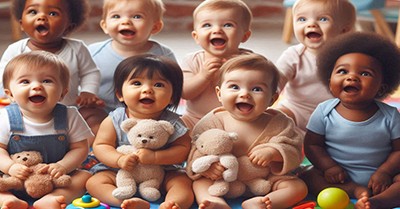




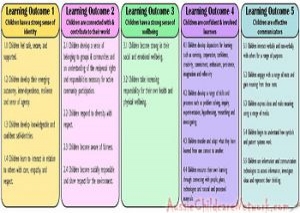 Here is the list of the EYLF Learning Outcomes that you can use as a guide or reference for your documentation and planning. The EYLF
Here is the list of the EYLF Learning Outcomes that you can use as a guide or reference for your documentation and planning. The EYLF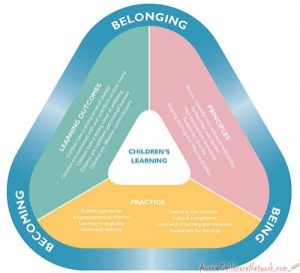 The EYLF is a guide which consists of Principles, Practices and 5 main Learning Outcomes along with each of their sub outcomes, based on identity,
The EYLF is a guide which consists of Principles, Practices and 5 main Learning Outcomes along with each of their sub outcomes, based on identity, This is a guide on How to Write a Learning Story. It provides information on What Is A Learning Story, Writing A Learning Story, Sample
This is a guide on How to Write a Learning Story. It provides information on What Is A Learning Story, Writing A Learning Story, Sample One of the most important types of documentation methods that educators needs to be familiar with are “observations”. Observations are crucial for all early childhood
One of the most important types of documentation methods that educators needs to be familiar with are “observations”. Observations are crucial for all early childhood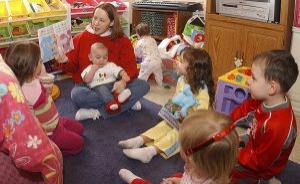 To support children achieve learning outcomes from the EYLF Framework, the following list gives educators examples of how to promote children's learning in each individual
To support children achieve learning outcomes from the EYLF Framework, the following list gives educators examples of how to promote children's learning in each individual Reflective practice is learning from everyday situations and issues and concerns that arise which form part of our daily routine while working in an early
Reflective practice is learning from everyday situations and issues and concerns that arise which form part of our daily routine while working in an early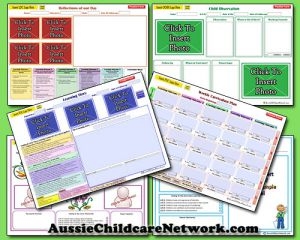 Within Australia, Programming and Planning is reflected and supported by the Early Years Learning Framework. Educators within early childhood settings, use the EYLF to guide
Within Australia, Programming and Planning is reflected and supported by the Early Years Learning Framework. Educators within early childhood settings, use the EYLF to guide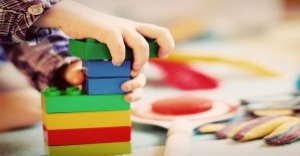 When observing children, it's important that we use a range of different observation methods from running records, learning stories to photographs and work samples. Using
When observing children, it's important that we use a range of different observation methods from running records, learning stories to photographs and work samples. Using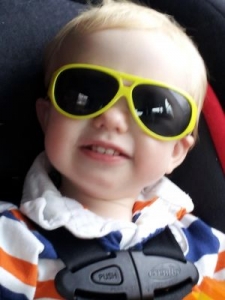 This is a guide for educators on what to observe under each sub learning outcome from the EYLF Framework, when a child is engaged in
This is a guide for educators on what to observe under each sub learning outcome from the EYLF Framework, when a child is engaged in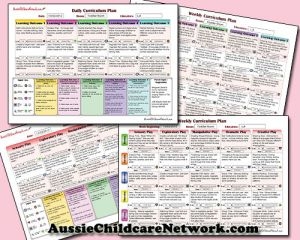 The Early Years Learning Framework describes the curriculum as “all the interactions, experiences, activities, routines and events, planned and unplanned, that occur in an environment
The Early Years Learning Framework describes the curriculum as “all the interactions, experiences, activities, routines and events, planned and unplanned, that occur in an environment

